
|
|

May 15, 2009
WJAR-TV/DT, Providence, R.I.
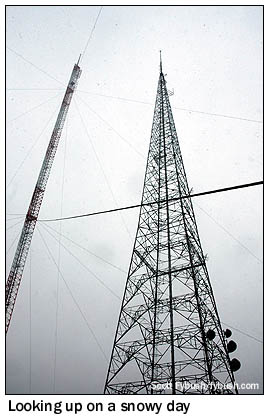 So
here we are - again - at the finish line for analog full-power
TV in the United States.
So
here we are - again - at the finish line for analog full-power
TV in the United States.
Unless it changes once more (and this time it looks pretty firm), June 12, 2009 will mark the end of more than seven decades of analog television, which means there are a whole bunch of transmitters, and a few transmitter sites, that we wanted to document here on Site of the Week before they're gone.
That's about the only excuse we can come up with for heading from upstate New York through Utica and Albany to Providence and Boston in early February, a season when we're usually either holed up at home or heading for warmer climates down south or out west.
But when a deadline is bearing down, no winter storm off the north Atlantic, like the one that greeted us on our first morning in the Providence market, is enough to keep a good tower-hunter down. (And we had the easy part, having spent the previous night in a motel in nearby Seekonk, Massachusetts; our tower-hunting compatriot Garrett Wollman had to drive down from his home near Boston in the slush and snow.)
In this week's installment, we visit the birthplace of commercial TV in Rhode Island...well, near Rhode Island, anyway: the site at 89 Pine Street in Rehoboth, Massachusetts, spitting distance from the Rhode Island border, that started out back in 1948 as the home of a pioneering Ocean State FM signal.
WJAR-FM (95.5) was the third FM in (or at least licensed to) Rhode Island when it debuted in May of 1948 from a transmitter at this site and an antenna high atop the self-supporting 454' tower that still stands here. The studios were at the Outlet Company department store in downtown Providence, which owned the FM station, its AM parent, WJAR (920), and a construction permit for WJAR-TV on channel 11.
WJAR-TV signed on July 10, 1949, providing the first local television service to a market that had already discovered the new medium through reception of the two signals from nearby Boston that had been on the air for more than a year - not to mention coastal DX from even older stations in New York City and New Haven.
Nearly 60 years later, WJAR-TV is still the NBC affiliate for Providence, and still broadcasting from this site, albeit with a few changes along the way. In 1952, it moved to channel 10, eliminating a short-spacing to WPIX-TV in New York and clearing the way for the eventual assignments of channel 12 to Providence and channel 11 for educational use in Durham, New Hampshire. In 1965, it built the 848' guyed tower that's now its primary tower. And along the way, it changed owners - from Outlet to NBC itself to Media General - and studio sites, eventually ending up at its current home in an office park in Cranston.
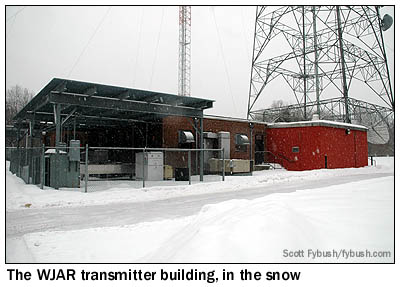 |
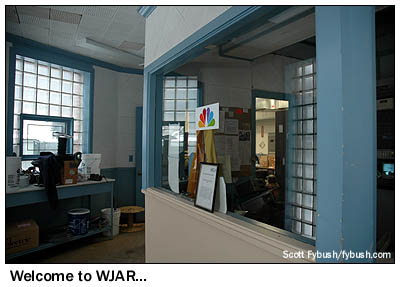 |
We didn't get to the studios on this trip, but that's OK - there was plenty to see out here at the transmitter site, where the coming of digital TV has brought some big changes.
Walking into the front door, it's almost still possible to believe it's 1949, with all that glass block and the glassed-in center office where a full-time engineering staff once tended the transmitters.
To the left is the original TV transmitter room, where the original pegboard walls overlook the space now occupied by the very last WJAR-TV analog transmitter, a Harris HT-series solid-state unit that could probably still have some life in it if WJAR-DT were operating on channel 10. (It isn't, thanks to the tight northeast allocations spacing that moves channel 10 to Connecticut, where it's occupied by WTNH-DT in New Haven; the channel is also being used, at lower power, by WWDP-DT in Norwell, Mass.)
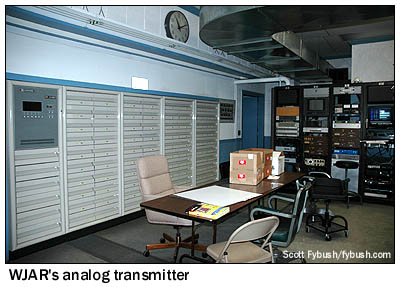 |
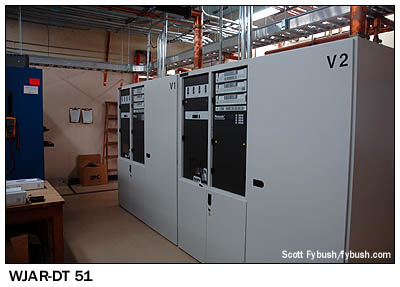 |
So WJAR-DT will stay on channel 51 - and for that transmitter, we have to go to the big room on the other side of the office. I suspect this was once the WJAR-FM transmitter room, and was apparently later used as a garage, but with the coming of DTV, the space was expanded considerably to provide room for multiple transmitters. (Another room was added on the side of the building to provide power-handling capacity for all those new transmitters; you can see it from the outside in the photo at the top of the page, painted red.)
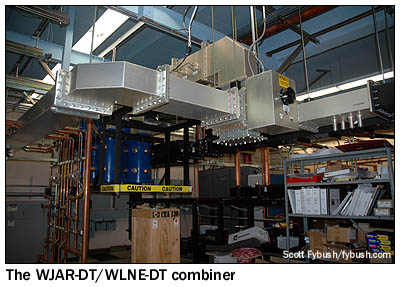 |
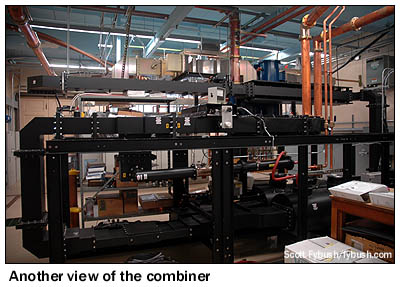 |
WJAR-DT itself operates from a pair of Thales transmitters that sit squarely in the center of the room, next to the hulking combiner/filter that sends WJAR-DT and ABC affiliate WLNE-DT (Channel 49) up to the side-mounted antenna just below the channel 10 antenna at the top of the guyed tower.
When WLNE-DT signed on from here, it represented a huge signal improvement for a station that had long been an also-ran in the Providence market. Third to the air in 1963, the former WTEV (Channel 6) never had a competitive signal over Providence - not just because it was (and is) licensed to New Bedford, Mass., 30 miles to the east, but also because spacing issues with WRGB in Schenectady restricted it to a transmitter site in Tiverton, R.I., southeast of Providence. With no such spacing issues on the DTV channel, it made perfect sense for WLNE to share this site with WJAR, and here it is, in the new part of the DTV room toward the back of the building.
(WJAR-DT has a construction permit for a new top-mounted antenna to replace its existing side-mounted antenna, once the analog channel 10 antenna is gone; it's reasonable to expect that WLNE-DT will seek to join it there, though it hasn't filed an application yet.)
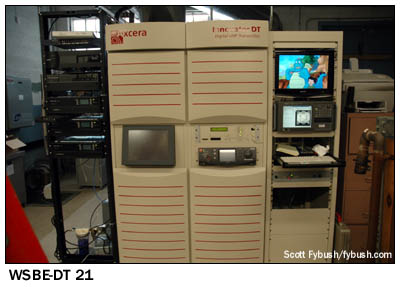 |
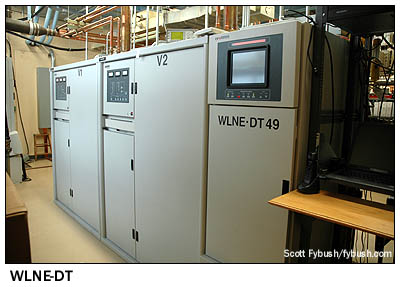 |
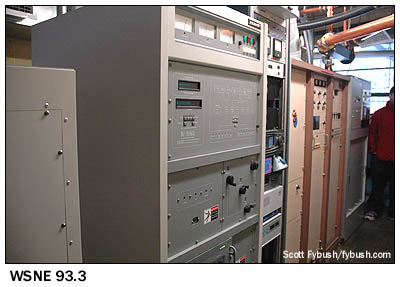 There's
one more DTV sharing this site as well: "Rhode Island PBS,"
WSBE-TV (Channel 36), decided not to put its digital transmitter
where its analog transmitter long sat, on Neuticonacanut Hill
in Johnston. (We'll see that site next week.)
There's
one more DTV sharing this site as well: "Rhode Island PBS,"
WSBE-TV (Channel 36), decided not to put its digital transmitter
where its analog transmitter long sat, on Neuticonacanut Hill
in Johnston. (We'll see that site next week.)
Instead, it located WSBE-DT 21 at the WJAR site, using a compact Axcera transmitter in the space behind the WJAR analog transmitter where the old power transformers probably once sat for WJAR itself, in the days of big tube transmitters.
There's one more loose thread to be tied up here, and that's the fate of WJAR-FM. By 1954, Outlet had pulled the plug on the FM signal, though the frequency would be reactivated a year later as independent WPFM, and a decade later would be sold to Brown University students to become WBRU-FM.
But Outlet didn't stay out of the FM business forever. In 1980, it sold WJAR(AM), which became WHJJ, and acquired independent FM station WRLM (93.3 Taunton MA), which became WSNE. As it turned out, Outlet didn't stay back in the FM business for long, either. WSNE eventually ended up in the hands of Beck-Ross Communications and later with SFX Broadcasting, which begat Capstar, which begat AMFM, which begat Clear Channel - which still owns WSNE, now known as "Coast 93.3" and still transmitting from the room that was added on to the side of the WJAR building in 1980.
Look carefully at the right edge of the WSNE transmitter room picture, right next to the BE digital transmitter, and you can see the red-jacketed figure of Mike Fitzpatrick, proprietor of the excellent NECRAT.com site that's chock-full of tower and antenna pictures...including some images of the towers and antennas on this site that are far superior to any we could get on this snowy February morning. Go pay a visit!
- Previous Site of the Week: Bakersfield, CA (Part II)
- Next Week: Providence, RI (Part II)
- Site of the Week INDEX!
- How can you help support Site of the Week? Click here!
- Submit your suggestions for a future Site of the Week!
